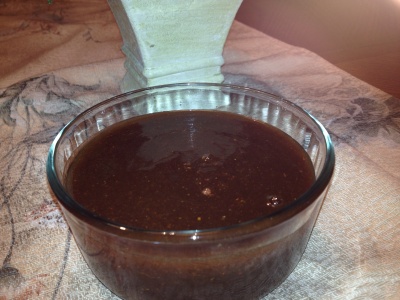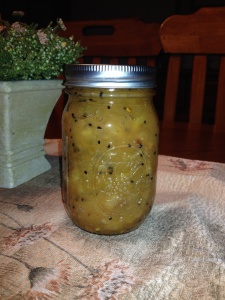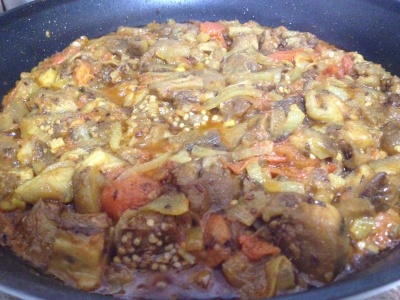Tamarind Chutney
- February
- 27
This chutney takes a bit of work to make. It doesn't take any cooking to make it other than heating the water to get the pulp from the tamarind. Most of the work is in getting the tamarind pulp separated from the fiber.
You start with one package of tamarind which is 8.8 ounces. Open the package and break the tamarind brick up into pieces and put them into a microwave safe bowl. Add 2 cups of water and put it in the microwave for about 4 or 5 minutes. Then let it sit for a while and soften. Use a fork to mash the tamarind up. Work on it until it turns into a thick liquid.
Use a metal strainer and a spoon over another bowl to get the pulp. Keep working the solids back and forth and scraping the strainer with the spoon and get as much pulp as you can. If it gets difficult you can put everything back into the first bowl and add a bit more water. The pulp will go through the strainer easier if the liquid is thinner.
I couldn't find any roasted cumin seed powder at the Indian grocery so I just made it myself. I dry roasted the cumin seeds and then used my mortar and pestle to grind them into a powder. The roasting certainly brings out the flavor of the cumin.
Once you have the tamarind pulp the rest is easy. You just mix in the sugar slowly and then mix in the other ingredients. You can add more water as required to get the desired thickness. For a dip you can leave it thicker, for a sauce add more water to make it thinner.
The most interesting ingredient in this chutney is the black salt. It is a salt with certain impurities in it that contain sulfur. You will notice the strong sulfurous odor it has when you add it in.
Let the chutney sit for a while before you serve it. This recipe makes quite a bit of chutney, maybe a few pints. You can keep the stuff in the refrigerator or freeze it for later.
Here are the ingredients:
1/2 lb (actually 8.8 oz) tamarind, seeded
2 cups of water plus more if needed
2-1/2 cups sugar
1-1/2 Tablespoons roasted ground cumin seeds
1 Tablespoon salt
1 teaspoon black salt
1 teaspoon red chili powder
1 teaspoon ground black pepper
1/2 teaspoon ginger powder
Mango Chutney
- February
- 26
This recipe uses cooking mangos which are much different than the usual ones for eating. They are green and sometimes reddish in color.
I pretty much followed Manjula Jain's recipe for this chutney. I did add a little more liquid toward the end of cooking because it seemed a bit too thick for me. The result was a sweet and pungent condiment. I think it would be especially good with meat, chicken or fish especially. It has a bit of a kick to it so you don't need too much to add flavor.
Here is the recipe restated:
2 Green cooking mangos, peeled and coarsely shredded
2 Tablespoons safflower oil
1 teaspoon calonji (onion seed)
4 dried red chilies
1 Tablespoon grated fresh ginger
2 Tablespoons golden raisins
1/2 teaspoon red chili powder
2 teaspoons salt
1 cup sugar
Peel the mangos and shred them coarsely. You should have 3-4 cups of shredded mango when you are done. Cooking mangos are very firm and white inside. The result looks like coarse cole slaw. Set this aside.
Heat the oil. When hot add in the calonji and the whole dried red peppers and stir, let them sizzle for a few seconds. Then add the rest of the ingredients, the shredded mango, ginger, salt, sugar and chili powder. Bring it back up to a boil. The mango will release moisture as it cooks. If it is too thick you can add some more water to thin it out some. Cook for 10-15 minutes on low-medium heat until mango is cooked soft and transparent.
If you want a thinner chutney you can add additional water as needed. It will thicken a bit as it cools.
Serve the chutney chilled or at room temperature or use it in cooking another dish. Store unused chutney refrigerated in a glass container or freeze it for later use.
Chilkewali Moong Dal
- February
- 26
Moong Dal (from the moong or mung bean) has a high protein to carbohydrate ratio. I used the split moong with the skin on which is a little chewier and probably healthier. This really is a heart warming food for a cold day. This is a Northern Indian recipe.
The recipe has a bunch of ingredients but the method isn't very hard at all. It is very close to the Chilkewali Moong Dal Recipe on spiceupthecurry.com but of course I scaled it up a bit to make extra. The recipe as published said it was medium spicy but I think it is pretty mild. I might have put a few chopped thai peppers in it but then my wife wouldn't touch it at all.
Here's what I did:
1 cup split moong dal with skin
3 cups of water plus a little more as needed/desired
3 small tomatoes, chopped
1-1/2 teaspoons grated ginger1-1/2 teaspoons garlic, chopped very fine.
1/2 teaspoon turmeric powder (haldi)
1-1/2 teaspoons coriander powder
3/4 teaspoon salt (to taste)
3 tablespoons canola oil
3/4 teaspoon mustard seed
3/4 teaspoon cumin seed
1-1/2 teaspoons red chili powder
1 teaspoon garam masala
few sprigs of cilantro (coriander) for garnish
Wash the moong dal thoroughly in a colander. Put the dal in the pressure cooker with 3 cups of water. Bring up to pressure and cook for 3 minutes more, turn off heat and let it cool down. While it is cooling, make the tadka.
For the tadka use a saucepan or a wok. Add the oil and heat until hot and a cumin seed dropped in cracks. Add the cumin seeds and the mustard seeds and cook til they crack (30 seconds maybe). Then add the grated ginger and garlic and cook for a few seconds. Add the tomatoes. Cook until they are soft (few minutes). Turn the heat off and mix in the red chili powder and the garam masala. Stir well to mix them in.
Remove the lid from the pressure cooker and turn the heat to simmer. Add the turmeric and coriander powder and stir them in. When bubbling, add the tadka. Turn the heat way down and stir and simmer for a minute then remove heat.
Serve garnished with fresh cilantro leaves.
Baingan Bharta
- February
- 25
Today I wanted to have some vegatables for lunch. I had a few eggplants that needed to be used so I made this Northern Indian curry dish, Baingan Bharta.
I think some people avoid eggplant because of the texture. This dish helps even it out because the eggplant is cooked until everything is very soft. The eggplant skin is removed so it is more uniform. The dish also contains tomatoes which are similar in texture.
The flavor of the dish is medium spicy with the familiar Indian flavors of cumin (jeera), turmeric (haldi) and coriander. There are also some chilies and red chili powder to give it some heat.
I started with this recipe from Manjula's Kitchen but then I took some exceptions. First of all, Manjula Jain avoids onion and garlic but I don't have a problem with them. I didn't put any garlic in but I did use some onion. For the recipe size as given I added one small onion, chopped. I didn't add any bell pepper, mostly because I didn't have any and my wife doesn't like peppers anyway.
The other thing I did was instead of making a puree with the tomatoes, chili and ginger I added them as-is to the pot. I like the tomatoes to be a bit chunky. So I made sure the ginger was finely chopped and added it at the same time as the tomatoes.
So here is the method I used:
Add oil to pan, heat until a cumin seed cracks when dropped in. Add cumin seeds and aesfoetida and stir for a few seconds. Add finely chopped chili and fry for few more seconds. Add onion, cook until almost transparent (about 5 or 6 minutes). Add chopped tomatoes and finely chopped ginger, coriander powder, haldi, red chili powder. Cook on medium heat until tomatoes are softened. Add the eggplant and reduce heat to simmer. Cover and stir every few minutes until eggplant is the desired texture (well cooked and very soft). Reduce heat to minimum, sprinkle in the garam masala and salt to taste. Mix a bit more and it's ready for serving.
Sambar
- February
- 7
Tonight I made Sambar, the traditional spicy lentil soup. Too bad I didn't have it earlier to go wuth the dosas. I used Manjula Jain's recipe.
The preparation was a little extra work because I needed tamarind pulp which takes some effort to make. You have to soak the dried tamarind in warm water and then mash it up. There are seeds and coarse fibers in the stuff so you have to work it with your fingers and then pass the whole mess through a sieve to get the pulp. Other than that it wasn't too hard but took a while overall to get the whole thing done.
I didn't have a pressure cooker so I just cooked the tor dal on the stove normally. That took much longer than it would have in a pressure cooker. It turned out fine though.
There are many different spices and flavors in this soup. It has lots of chilies in it which you can see from the picture. There are also curry leaves which have a sort of citrus flavor. There are methi seeds, mustard seeds, cumin, and sambar powder (not sure what all is in that stuff).
The recipe goes together in two parts. The dal cooks in a big pot with some turmeric and salt. The spices are prepared separately and then added in. I used a wok to cook the spices and vegetables. The recipe called for vegetables like carrots, zucchini, radish and green beans. I decided to just throw a bag of frozen california vegetables in instead. So I had cauliflower and carrots and a little broccoli along with the tomatoes that the recipe calls for. I think you could put whatever you want in there really.
The spices are cooked in a little oil and then the vegetables are added and simmered. The wok worked great for that. Once the veggies are tender I added the spices into the cooked dal and simmered the whole thing for another 10 minutes or so. It's really delicious and very healthy. I had a big bowl and I'm going back for seconds.
I quadrupled the recipe so I have lots of soup to eat over the next few days and some to freeze for later too.







